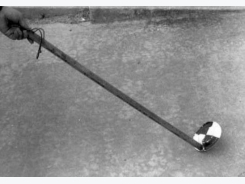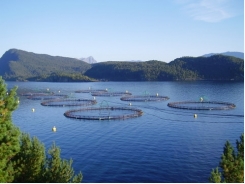Drying, Liming, Other Treatments Disinfect Pond Bottoms

Drying pond bottoms between cycles is the first step toward disinfection. Puddles and wet areas should receive lime or another effective treatment to eliminate unwanted organisms.
Summary:
The traditional way of destroy-ing organisms in pond bottoms is thorough dryout for one to two weeks or longer. Following dry-out, fish toxicants and liming can kill unwanted wild fish, parasites and disease organisms and their vectors that survive in wet areas. The objective of lime treatment is to raise pH to 11 or 12 to kill unwanted organisms. Liming and other treatments are often exe-cuted at insufficient concentra-tions to be fully effective.
In pond aquaculture, managers should attempt to prevent disease and other unwanted organisms from surviving in the bottoms of empty ponds between crops. They also should make efforts to prevent unwanted organisms from entering when ponds are refilled with water for the next crop.
Dryout, Toxicants, Liming Compounds
The traditional way of destroying organisms in pond bottoms is thorough dryout for one to two weeks or longer. This procedure is effective in areas where the bottoms will completely dry, but in ponds where the water table is near the surface or seepage enters from adjacent ponds, puddles and wet areas remain. Moreover, during rainy periods, it is not possible to dry pond bottoms well.
Wild fish in puddles can be destroyed with rotenone or other fish toxicants. However, of greater concern are parasites and disease organisms and their vectors that can survive in wet areas to infect the next crop. It is common to treat wet areas or sometimes entire pond bottoms with burnt lime, calcium oxide; or hydrated lime, calcium hydroxide. The objective of lime treatment is to raise pH to 11 or 12 to kill unwanted organisms.
Trials on small plots of empty pond bottoms showed that 100 g/m2 of lime raises soil pH to about 10, and a recent laboratory study found that lime treat-ment of 300-500 g/m2 caused soil pH to rise to 11Few pond managers use lime rates even as high as 100 g/m2, and in many cases, liming of wet areas probably does not have the expected effect. To assure a pH high enough to kill unwanted organ-isms, the treatment rate should be at least 200 g/m2 for burnt lime and 300 g/m2 for hydrated lime. Following application, lime is transformed to soil carbonate by reaction with carbon dioxide, and pH falls to 8.5 or less within a few days.
Calcium Hypochlorite
An option for disinfecting wet areas is to apply calcium hypochlorite, also known as high-test hypochlorite (HTH). Treat-ment rates of 25-50 g/m2 usually are applied, but laboratory studies suggest that rates three or four times greater are needed to cause a reduction in the abun-dance of bacteria in wet soil.

Figure 1. Con-centration of calcium hypo-chlorite neces-sary to provide 1 mg/L of hypo-chlorous acid at different pH values.
Water for refilling ponds often is held in reservoirs for several days before being introduced into ponds. This practice pos-sibly eliminates free viral particles, but not their vectors. Filtering water through fine-mesh filters removes wild fish and shrimp, microcrustaceans and other com-mon vectors, but smaller organisms pass through the filters. Biocides can be applied to reservoirs or ponds in lieu of filtration, or both treatments can be used.
Calcium hypochlorite can be used to dis-infect water for refilling ponds. The disin-fecting power of HTH treatments depends upon the hypochlorous acid:hypochlorite ion ratio, which decreases as pH rises. The HTH doses necessary to provide 1 mg/L of hypochlorous acid at different pH values are provided in Figure 1.
Water for aquaculture ponds usually has a pH around 8, and studies have shown that the effective HTH concentra-tion for disinfection usually is 20-30 mg/L. Thus, disinfection of pond water with HTH is quite expensive.
Hypochlorous acid and hypochlorite con-centrations quickly decline – usually within a few days following treatment. Chlorine com-pounds are reduced to non-toxic chloride ionsthrough reactions with organic substances and the effects of sunlight.
Chlorine Gas
Because of the high cost of HTH, some farms have used chlorine gas as a disinfectant. At the pH of waters in aquaculture systems, chlorine gas is trans-formed to hypochlorous acid and hypo-chlorite ions.
Chlorine is a highly poisonous gas, and the transport and handling of con-tainers of chlorine are fraught with dan-ger. Major lethal accidents have resulted from transporting chlorine gas for indus-trial purposes. Its use at aquaculture facil-ities is not recommended.
Insecticides
Often referred to as DDVP, dichloro-vos is an organophosphorus insecticide with the chemical name 2,2-dichlorovinyl dimethyl phosphate. This compound provides a cheaper alternative to HTH for disinfection of water in aquaculture ponds. It is effective at much lower con-centrations than HTH, with treatment rates of 1-3 mg/L effective in destroying disease vectors.
Because DDVP is an insecticide, its use in aquaculture tends to alarm envronmentalists and other people. How-ever, within three or four days after appli-cation, DDVP concentrations decline to an undetectable level in water. In reality, DDVP is a safer compound than HTH for disinfecting pond waters.
DDVP often is marketed in Asia as pondvos or crusticide for use in shrimp ponds. It is used in reservoirs before water is transferred to ponds or in ponds treated after refilling but before they are stocked with postlarvae. In shrimp ponds, several months pass between treatment with DDVP and harvest, and there is no likelihood of DDVP contamination of shrimp harvested from ponds previously treated with this compound.
Toxicity Considerations
Fish toxicants, lime, HTH and DDVP can be toxic to aquatic organisms if accidentally spilled into natural waters, so they should be stored and used in a responsible manner. Fish toxicants are not especially toxic to humans, but work-ers should take precautions to minimize contact with them. Lime is caustic, and can burn the skin and cause serious eye injury – even permanent blindness.
Workers should wear protective clothing including eye protection and gloves. Workers also should be provided respiratory protection to avoid inhaling HTH and DDVP. HTH should never be put into highly acidic water with pH below 4, because chlorine gas will be gen-erated. Nevertheless, lime, HTH and DDVP can be used safely if proper pre-cautions are taken.
Pond Preparation After Disinfection
Drying of bottom soils and chemical disinfection of bottom soil and water kills unwanted and desirable organisms alike. After drying and chemical treatment, benthic and plankton organisms are in low abundance.
Postlarval shrimp or fingerling fish should not be stocked until populations of natural food organisms have re-estab-lished. Fertilization of pond bottoms with organic matter immediately before refilling and application of urea and tri-plesuperphosphate to the water during and after refilling – but before stocking – hasten the development of benthos and plankton
Related news
Tools

Phối trộn thức ăn chăn nuôi

Pha dung dịch thủy canh

Định mức cho tôm ăn

Phối trộn phân bón NPK

Xác định tỷ lệ tôm sống

Chuyển đổi đơn vị phân bón

Xác định công suất sục khí

Chuyển đổi đơn vị tôm

Tính diện tích nhà kính

Tính thể tích ao



 Dissolved-Oxygen Requirements In Aquatic Animal Respiration
Dissolved-Oxygen Requirements In Aquatic Animal Respiration  Embodied Resource Use In Feed-Based Aquaculture
Embodied Resource Use In Feed-Based Aquaculture